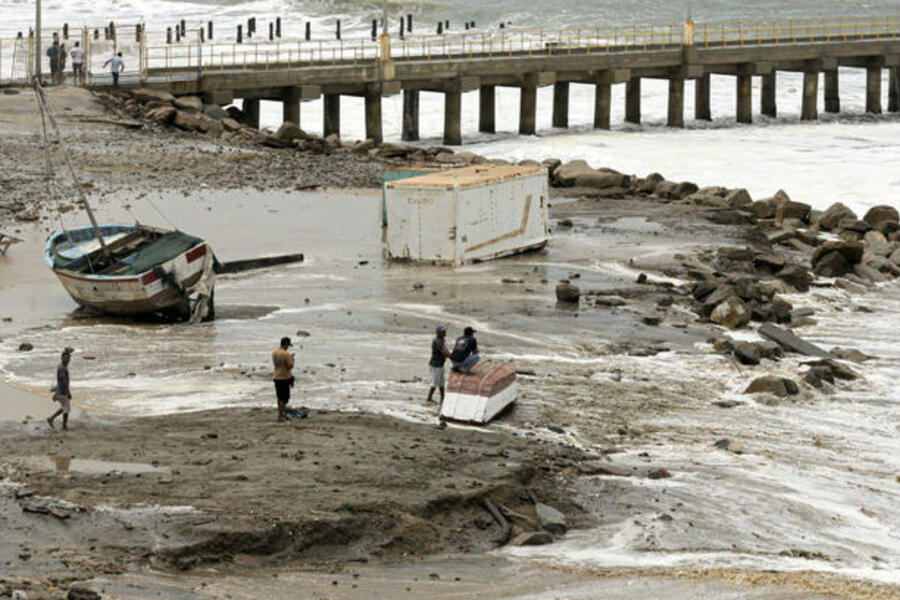Giant waves that struck the coastlines of Ecuador and Peru over the weekend have caused severe damage, resulting in at least one fatality in Ecuador and significant disruptions in Peru. With waves reaching up to 13 feet in height, local authorities have been working tirelessly to manage the aftermath of this natural disaster.
In Ecuador, the National Secretariat for Risk Management confirmed the recovery of a body in the coastal city of Manta, located on the western coast of the country. The body was that of a missing individual, found early in the morning by the Manta Fire Department in the Barbasquillo area. This death has left a somber mark on the country, and local officials have pledged to continue their rescue and recovery efforts.
Meanwhile, in neighboring Peru, the giant waves wreaked havoc across several coastal cities, submerging piers, flooding public spaces, and causing extensive property damage. The waves have also caused people to flee to higher ground for safety. Local media outlets reported images showing submerged jetties and squares, highlighting the severity of the situation. The waves’ destructive power forced local authorities to close numerous beaches to protect citizens from further danger.
To mitigate the impact, Peru has closed 91 out of its 121 ports, with these closures expected to last until January 1. This is a significant move, as these ports are vital for both local fishing operations and national shipping. The closure of ports has had a considerable impact on the fishing industry, and small businesses near the sea have also been affected by the flooding and damages.
The severity of the waves is being attributed to a persistent wind force that originated thousands of miles away, off the coast of the United States. According to Navy Captain Enrique Varea, the winds generated large swells in the Pacific Ocean, which then traveled across the vast expanse of the ocean, reaching the coasts of Ecuador and Peru. The impact of this wave system has been catastrophic, causing widespread destruction to coastal infrastructure and leaving the region facing significant recovery efforts.

The scale of the destruction has drawn national attention, with many questioning the long-term effects of such extreme weather events. The waves not only caused a loss of life and property damage but also disrupted essential industries like fishing, tourism, and local businesses. Small fishing boats, particularly in coastal towns, have been damaged or destroyed, and many businesses have been left to deal with the financial toll.
In light of the devastation, both Ecuador and Peru have initiated relief operations, working to provide immediate assistance to affected residents. The local governments are focusing on ensuring the safety of citizens, with emergency crews and first responders continuing their efforts to assist those in need. As the cleanup and recovery process begins, officials are calling for enhanced protections for coastal regions, highlighting the vulnerability of these areas to natural disasters.
The catastrophic waves serve as a stark reminder of the unpredictable and destructive power of nature. The situation is being closely monitored, and authorities are urging residents to stay informed and follow evacuation orders as necessary. The aftermath of these waves underscores the importance of disaster preparedness, particularly in regions prone to extreme weather events.
The incident also raises questions about the broader implications of climate change, as the frequency and intensity of extreme weather events seem to be increasing. While the waves were a natural occurrence, experts are concerned about the long-term impacts of global warming on ocean systems and coastal communities. The rising sea levels and changing weather patterns may lead to more frequent and severe storm events, posing greater risks to vulnerable coastal regions.
The giant waves that struck Ecuador and Peru have left a trail of destruction, loss, and disruption. With one fatality confirmed in Ecuador and significant damage across Peru, the region faces a challenging recovery ahead. The immediate focus is on assisting those affected, but the broader questions surrounding climate change and disaster preparedness remain. As the global community grapples with the increasing frequency of extreme weather events, the need for resilient infrastructure and sustainable practices has never been clearer. The recovery efforts in Ecuador and Peru will likely serve as a blueprint for future responses to similar disasters worldwide.


